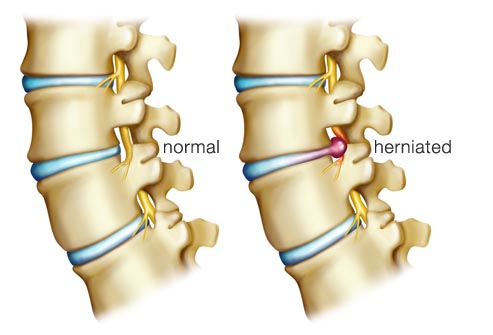Unit 2 Text A Herniated Disc (Disc Herniation of the Spine)
第二單元 主題A 椎間盤突出癥
Many patients with back pain, leg pain, or weakness of the lower extremity muscles are diagnosed with a herniated disc.
許多患腰腿疼痛,下肢肌端乏力的病患均為椎間盤突出癥。
When a disc herniation occurs, the cushion that sits between the spinal vertebra is pushed outside its normal position.
椎間盤突出發(fā)生時(shí),脊柱間的緩沖帶將發(fā)生側(cè)突。
A hrniated disc would not be a problem if it weren't for the spinal nerves that are very close to the edge of these spinal discs.
如果脊神經(jīng)不是離椎間盤特別近的話,椎間盤突出就不是什么大問題了。
HOW ARE THE SPINE AND ITS DISCS DESIGNED?
脊柱與椎間盤
The vertebras are the bony building blocks of the spine.
脊椎是建造脊柱的構(gòu)件。
Between each of the largest parts (bodies) of the vertebrae are the discs.
各椎骨之間為椎間盤。
Ligaments are situated around the spine and discs.
脊椎和椎間盤周圍散布著韌帶。
The spine has seven vertebrae in the neck (cervical vertebrae), 12 vertebrae in the mid-back (thoracic vertebrae) , and five vertebrae in the low back (lumbar vertebrae).
頸部有7條椎骨,胸部為12條,腰部有5條。
In addition, in the mid-buttock, beneath the fifth lumbar vertebra, is the sacrum, followed by the tailbone (coccyx)
此外,在臀部中央,第五條腰椎下面為薦骨,再往下是尾骨。

The bony spine is designed so that vertebrae "stacke" together can provide a movable support structure while also protecting the spinal cord ( nervous tissue that extends down the spinal column from the brain) from injury.
椎骨之間“層層疊加”,支撐身體移動(dòng)構(gòu)架,并保護(hù)脊髓(大腦神經(jīng)組織在脊柱的延伸)。
Each vertebra has a spinous process, which is a bony prominence behind the spinal cord that shields the cord s nerve tissue.
每個(gè)椎體都有一個(gè)棘突,即位于脊髓后方、保護(hù)脊髓神經(jīng)組織的骨性突起。
The vertebrae also have a strong bony "body" in front of the spinal cord to provide a platform suitable for weight-bearing.
脊髓外部為椎骨,椎骨是人體的負(fù)重部位。
The discs are pads that serve as "cushions" between the vertebral bodies that serve to minimize the impact of movement on the spinal column.
椎間盤充當(dāng)各椎體間的“襯墊”,椎體的作用是承受負(fù)重,將脊柱壓力減到最小。
Each disc is designed like a jelly donut with a central softer component ( nucleus pulposus).
椎間盤就像果凍甜甜圈,中間為軟組織髓核。
Ligaments are strong fibrous soft tissues that firmly attach bones to bones.
韌帶由極具彈性的纖維軟組織組成,連接骨與骨。
Ligaments attach each of the vertebrae and surround each of the discs.
韌帶與每條椎骨相連,并附著在椎間盤周圍。
When ligaments are injured as the disc degenerates, localized pain in the area affected can result.
隨著椎間盤退行性變,韌帶損傷,疼痛在所難免。
WHAT IS THE SPINAL DISC?
什么是椎間盤
The spinal disc is a soft cushion that sits between each vertebra of the spine.
各椎體之間存在著充當(dāng)“緩沖墊”的椎間盤。
This spinal disc becomes more rigid with age.
隨著年齡增長,椎間盤出現(xiàn)僵化。
In a young individual, the disc is soft and elastic, but like so many other structures in the body, the disc gradually looses its elasticity and is more vulnerable to injury.
對(duì)于年輕人而言,椎間盤柔軟既富彈性,像其它部位一樣,椎間盤也會(huì)逐漸失去彈性,受傷風(fēng)險(xiǎn)增加。
In fact, even in individuals as young as 30, MRIs show evidence of disc deterioration in about 30% of people.
事實(shí)上,根據(jù)核磁共振顯示,像30歲年輕人,椎間盤的退行性變比例達(dá)30%。
譯文屬可可英語原創(chuàng),未經(jīng)允許,不得轉(zhuǎn)載。











